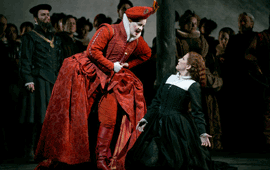> [Archived] Chronicles

Maria Stuarda by Donizetti, Live in HD
For the MET, Maria Stuarda (which premiered at the famous La Scala in Milan on 30th December, 1835, with Maria Malibran in the title part) is a first-ever production. There was huge interest from the audience and the success exceeded all expectations, especially due to the two leading ladies: Joyce DiDonato as Maria Stuarda and Elza van den Heever as Elisabetta.
We watched the performance in a HD live broadcast from the Metropolitan Opera in New York on Saturday, 19th January, 2013. As usual, the place was one of the halls of the Light Cinema in Liberty Mall, Bucharest. It represented a unique and amazing opportunity for a real-time participation in an exceptional artistic event. The performance was also broadcast live by Radio Romania Music, but the cinema hall added the enjoyment of image to that of the audition.
As we already know, MET's productions are magnificent, impressive. Going backstage during the intervals often reveals the numerous and complex activities performed in the wings by an army of professionals. For Maria Stuarda, in perfect agreement with the director, the scenographer John MacFarlane devised and built a set containing few elements, but solid and vividly-coloured: a blood-red wall of a palace hall, a forest with a few bare trees and a huge, threatening dark sky in the background, the stylized interior of a prison cell with its black walls covered in the minute writing which evokes the letters sent by the prisoner to the free world outside, a huge staircase at the end of which the executioner and Death are supposed to be waiting. The costumes are spots of colour moving on this set - white and blood-red for Elisabetta and her courtiers, black with a little brilliant white for Maria and her ladies in waiting. This kind of set involves large acting spaces, which are not always comfortable. The artists have to cover them and they are not always successful. Instead, they attempt to compensate through the force of the characters, the beauty of the music and the quality of their vocal interpretation. Most of them succeed.
When it comes to interpretation and music, we have to begin with Joyce DiDonato and the part of Maria Stuarda, the mezzo version (originally, both lead female roles were written for sopranos). We have often watched Joyce DiDonato perform on the MET stage in various roles, from Octavian in Der Rosenkavalier by Richard Strauss to another travesty part in Le Comte Ory by Rossini and now, in this amazing bel canto demonstration signed by Gaetano Donizetti. Every time, the artist amazed and delighted through the quality of her voice, the stylistic accuracy, the sensitivity and realism of the interpretation, her capacity to get inside a part. Nothing seems impossible for the voice of the American mezzo-soprano and the experience, confidence and poise given by the famous MET stage offered the artist the opportunity to grow spectacularly with each new part. With Maria Stuarda - a complex role, with emotions widely ranging from the despair of knowing that death is near, to the hope of the woman in love that the man she loves will make the impossible possible, and to the pride of a queen who has the strength to confront her rival to the throne, aware that she will thus sign her death sentence - Joyce DiDonato adds to her repertoire another impressive success on the international stage of the lyric theater.
For Elza van den Heever, the 33-year old South-African soprano, this performance represented her debut on the great MET stage. A debut crowned by absolute success. A good cast for the part, with a metallic, almost rough voice, deeply contrasting with that of the mezzo-soprano, Elza van den Heever builds and thinks her part to the minutest details. Backstage sources revealed that she didn't hesitate to shave her head so that her image should be as close as possible to the character she embodies. The heavy-footed walk, the masculine attitude, the complete lack of grace and an incredibly easy-to-read and mobile face expression are the final touches in a role to which the voice, able to move easily between the registers and take on a great variety of expressions and nuances, matching all feelings and situations, brings substance and inner beauty. All during the performance, we witnessed the evolution of two great artists, embodying two powerful personalities, perfectly rendered by Donizetti's music.
Under the circumstances, the only masculine part, that of Robert Dudley (Roberto) has, unfortunately, little chance of coming to prominence. That is why, although from a musical point of view, the interpreter did his part, all I can remember from the tenor Matthew Polenzani's performance is an inconspicuous and even slightly funny presence.
The conductor Maurizio Benini and his orchestra deserve only praises. The musician gave life and sense to every note in the score and even if all he could use was a traditional and poor accompaniment, he managed to bring colour and expressiveness to it. Under his baton, the voices and instruments reached perfect harmony, creating a real musical masterpiece. Full of interest and curiosity, we are looking forward to watching the last opera of the Tudor trilogy, the performance of Roberto Devereux.
Translated by Mihaela Olinescu and Elena Daniela Radu
MTTLC, Bucharest University














